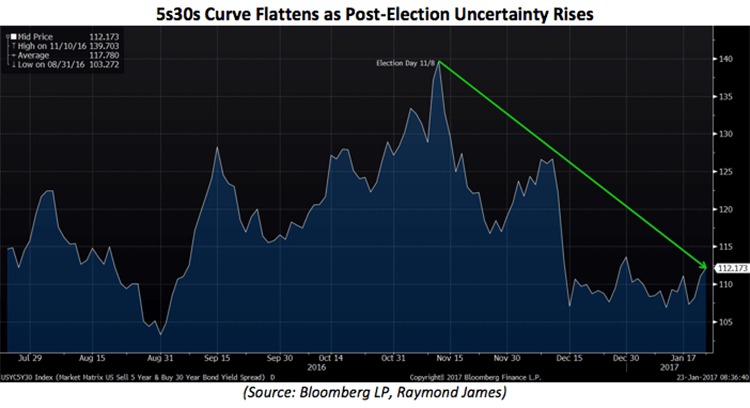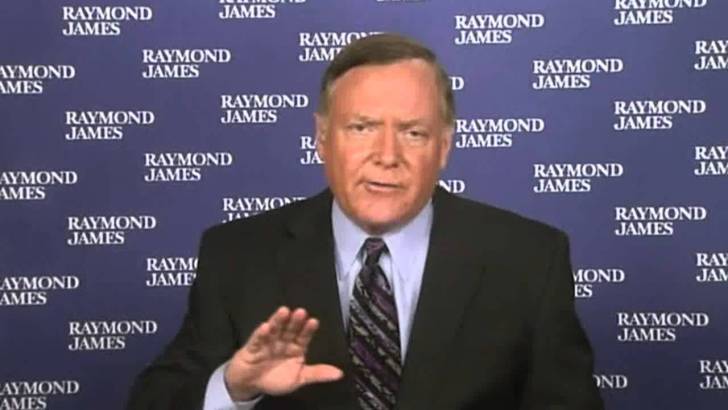by Benjamin Streed, Fixed Income, Raymond James
It’s official, Donald Trump is the 45th President of the United States yet the markets seem to be at an interesting crossroads. We’re seeing the markets reconsider the post-election Trump rally as much of the prospective benefits of new policy have already been priced into both equity and bond markets around the world. In the immediate aftermath of the election domestic stocks rose alongside bond yields as many around the globe anticipated that Trump’s mix of fiscal stimulus, tax cuts and other pro-growth policies would bolster the US economic situation and lead to further prosperity. In a classic iteration of “buy the news, sell the story”, the markets now seem to be questioning Trump’s ability to implement his grandiose plans as recent confirmation hearings have proffered minor clues on this administration’s agenda alongside of some conflicting rhetoric from Trump himself. The catalyst for the recent rally: tax cuts, regulatory rollbacks, infrastructure spending, inflation and jobs, jobs, jobs and more jobs. All these promises, and yet it took just a single press conference for markets to reconsider their recent bullishness. Interestingly enough, it seems each time Trump speaks the markets react similarly and the bullishness shows a bit of a wobble.
In the study of human psychology there’s a fascinating term called “cognitive dissonance”, whereby an individual exhibits stress or discomfort as a result of holding two or more contradictory beliefs, ideas or values at the same time. The hype and high-energy rhetoric espoused by the Trump campaign is finally causing markets to second guess the likelihood any such policy changes will be enacted, as well as how large or small their effects may be on a US economy that finds itself in the later stages of a recovery. Equities are priced with high valuations on expectations that earnings will increase in coming years, but longer-term bond yields remain wary of any such promise (10yr Treasury yields sit at ~2.50% while core inflation was last reported at 2%). The winner of the stocks versus bonds debate will be interesting to watch.
Meanwhile, the Fed continues to be a focal point, albeit less so than in recent memory. Chair Janet Yellen reemphasized last week that the central bank expects to normalize rates throughout the coming years, eventually leaving the fed funds rate near 3% by the end of 2019. Considering we’ve already seen two rate hikes, one in each of 2015 and 2016, and this implies a rather glacial pace towards normalcy, something the markets will have to reconcile as Trump pushes for pro-growth/inflation initiatives. Should the two powers-that-be get out of alignment this could spark further inflationary pressures, likely to be reflected in the markets as inflation expectations take hold. On that note, last week’s auction of 10-year Treasury Inflation Protected Securities (TIPS) drew record demand from indirect bidders, a group that includes foreign central banks and mutual funds. This contingent took down 77% of the $13 billion auction, well above the roughly 66% historical average. The appetite for inflation protection could continue to see strength as markets will wrestle with the uncertainty regarding Trump’s policy initiatives with the backdrop of a more hawkish (pro rate hike) Fed in 2017.
Here’s something to keep an eye on moving forward: the bond markets are showing us that policy uncertainty (both monetary and fiscal) is becoming, for lack of a better phrase, more certain. As uncertainty rises, the intermediate potion of the yield curve, 5- to 10-year maturities, tends to rise more relative to the front and back-ends of the curve. As a result of this uncertain situation, the 5s30s curve, the difference in yield between the 5- and 30-year maturities, has declined to the lowest levels since the election. This is odd considering recent inflation data, and the TIPS auction mentioned above, clearly indicate expectations for rising inflation in the coming years.
Copyright © Raymond James

















